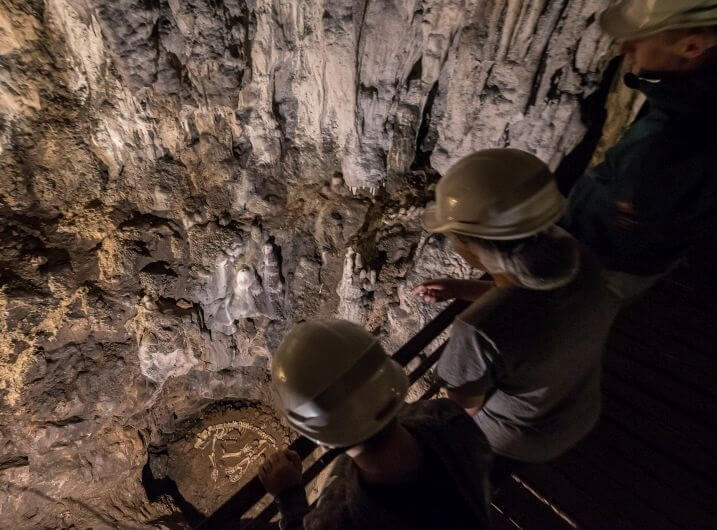Neanderthal Stone Tool Found at New Excavation Site in Croatia
February 13th, 2022 - An incredible discovery was made in the Upper Barać Cave in Rakovica near Plitvice Lakes. A stone tool known as a scraper points to the presence of the Neanderthals, putting the cave on the international map of notable archaeological sites
Speleologist Hrvoje Cvitanović and archaeologist Jana Frdelja, members of the speleological club Ursus Spelaeus from Karlovac, discovered an artefact that is believed to be a tool used by the Neanderthals in the Mousterian age, reports tportal. Namely, it’s a stone tool referred to as a scraper.
'As restoration works were being carried out in the entrance part of the Upper Barać Cave, namely as a protective fence was being installed around the existing probe with displayed artefacts, I found a stone tool that seemed very interesting to me right away, primarily because the artefact was located next to a phalanx and a teeth of the cave bear, and secondly, because I have never seen chert [stone] shaped this way except in scientific literature. This was an incidental find, because if we had decided to place the pillars only a few centimetres away, this tool would have remained buried under layers of soil. I felt extremely pleased because we’re talking about a rare discovery that has the potential for further research whose outcome is likely to have not only national but international significance’, said Cvitanović.
Igor Karavanić PhD, a professor at the Department of Archaeology of the Faculty of Humanities and Social Sciences in Zagreb explained the tool was a very interesting scraper made of high quality material.
‘Such tools are typical of the Middle Paleolithic, namely the Mousterian age, which in Europe is always associated with Neanderthals. Sometimes they can date to an earlier period, so it's difficult to draw conclusions in terms of culture with 100% certainty based on a single artefact, but this is a very typical scraper found in the Mousterian, and given the information I received from those who participated in the excavation, it’s very likely that this is related to the Neanderthal. This would mean that we have another, new Middle Paleolithic site in Croatia where Neanderthals were present for at least a short period of time, judging by the artefact found in the Barać Cave’, said Dr. Karavanić. He’s of the opinion that this discovery should be taken as an incentive for further research, as it gives great value to the site and proves the presence of man in a period which is very attractive not only for national science but on the international level as well.
Together with outside collaborators, the Barać Cave Public Institution revealed the results of recent research, conducted in the cave in 2020 and 2021 with the aim of preservation, maintenance and promotion of natural treasures in the area of Rakovica Municipality.
'We consider this extraordinary discovery to have potential for further socio-economic development of tourism in our area. Our goal is to achieve recognizable national importance through further exploration of the Upper Barać cave, which should be improved by promoting it on the world tourist market and participating in international scientific events. These results are great motivation for us to continue our research, because truly, wherever we scratch the surface, we find something! After all, caves are the last unexplored areas on Earth. We will not stop here', said Tihana Oštrina, the director of the Barać Cave Public Institution.
Encouraged by this phenomenal discovery, the institution plans to continue the research in the entrance part to the Upper Barać cave in cooperation with the Ministry of Culture, the Ursus Spelaeus speleological club, the Department of Archaeology at the Faculty of Humanities and Social Sciences in Zagreb and the University of Wyoming in the USA.
A specific goal of theirs is to study the layers of Neanderthal artefacts that would confirm the activity of Neanderthals and help determine to which extent they were present in the Upper Barać Cave; as research is carried out, it will be necessary to confirm there was recurrent activity in the cave.
10 Reasons to Visit Lika's Interesting Barac Caves in Spring
Located in the heart of Lika, the Barac caves are one of the many treats of this landlocked region often neglected in comparison with Istria, Dalmatia or Kvarner. Despite that, this area has been gaining more and more attention over recent years. Jutarnji List recently provided ten reasons to Croats as why they should visit the Barac caves in spring, and here at TCN, we don't see why they couldn't apply to our non-Croatian readers too. So, here are ten reasons to visit the Barać caves, according to Jutarnji List.
1.) The location is easy to get to
From the Croatian capital of Zagreb, you need to drive only 130 kilometres or, in other words, a little under two hours. The trip is a little bit longer if you come from Rijeka (170 kilometres) or Zadar (150 kilometres). Once you reach the village and municipality of Rakovice, you can easily follow the signs to the Barac caves.
2.) This destination is part of a world-renowned tourist offer
Located close to the oldest National Park in Croatia, Plitvička Jezera (Plitvice Lakes), the Barać caves are part of Lika's offer as a destination, which is placed in the top 100 sustainable destinations and the top 15 finalists.
3.) They're weekend trip perfection
The Barac caves are an excellent spot for a one-day field trip. Along with touring the caves, there are additional offers of hitchhike tracks, a children's playground, a picnic area, a badminton court, and more.
4.) They're just as perfect for active vacation lovers
With two nearby adrenaline parks, the ability to rent quads and bikes, as well as and organised cycling tours and horse-riding through the Plitvice valleys, there's no chance of you running out of things to do. With some pre-arrangements, you can also visit the Dolina Jelena (Deer Valley) ranch in town of Drežnik, where you can come close and even feed the deer there.
5.) It's for all ages
To enter the cave, there is a light 200 metre uphill stroll that doesn't require much of a physical effort. You can tour this area only accompanied by a guide whose interpretation and info is suitable for all ages.

© Denis Stošić / Lika Destination
6.) It's the home of bats
Rhinolophus ferrumequinum and Rhinolophus hipposideros are two types of bats you can find in almost every auditorium of the upper Barac cave. And with the coming of spring, they're waking up and hunting bugs which is an excellent opportunity to learn more about them.
7.) Cave bear memorabilia
30.000 year old remnants of a cave bear are displayed within the Barac caves which is extremely rich in both archaeological and paleontologist findings with remains from the Ice Age all the way to the Middle Ages.
8.) Face your fear of the dark
The Barac caves are lit up, but you can also experience the cave in its natural ambient - in complete darkness with the sound of water drops. It's scary at first, but exciting and relaxing at second sight.
9.) An idividual approach
To organise an event it takes two adults who will be accompanied by a guide. Tickets don't need to be bought up-front, and the guy welcomes you at the info counter. The tour is organised upon your arrival. Before arranging the tour, the guide will give you some basic information before you purchase a ticket, and the tour lasts for about 60 minutes.
10.) Happy customers
Tripadvisor awarded Lika's stunning Barac caves with the ''Travellers choice'' title meaning they're among the top 10 percent of the best destinations on Tripadvisor and are constantly receiving new and excellent reviews. Google also awarded the Barac caves with a rating of 4.7/5 and Facebook gave them a 5/5.
For more about travel in Croatia, follow TCN's dedicated page.


